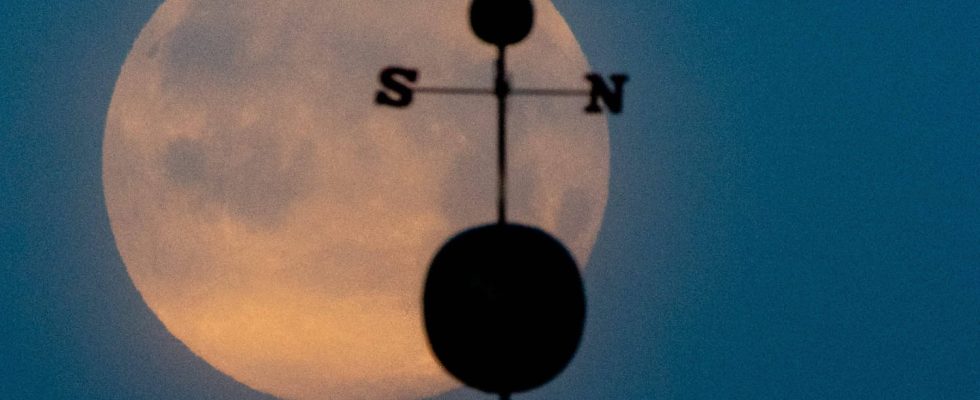SUPER MOON. This Monday, July 3, 2023, the “Super Deer Moon” will occur. What time to observe it? How far from Earth? All about the astronomical phenomenon and its effects.
[Mis à jour le 2 juillet 2023 à 21h20] The first Super Moon of the year, also called the “Super Deer Moon”, will occur this Monday, July 3, 2023. In the night sky, the full moon will appear 5.8% larger and 12.8% brighter than usually at the time of the “perigee-syzygia” phenomenon, when the full moon is at the point of its orbit closest to the Earth.
The weather being particularly mild throughout France, its observation will be greatly facilitated and the best photographers will have the chance to capture the star in their lens, sometimes creating astonishing optical effects! At what time and how to observe the Super Moon? Why is it a Super Moon and what is the origin of its name? How far is it from Earth? What are its effects ? All the answers to your questions below:
The next Super Moon falls this Monday, July 3, 2023. The Moon will be “Super” exactly at 1:39 p.m., located at a distance of 361,934 kilometers from our Earth. While waiting to observe the Super Moon on July 3, discover the most beautiful pictures of Super Moons taken around the world, from the United States to Australia via Europe, in 2022:
| DATE | HOUR | DISTANCE FROM EARTH |
| Monday July 3 | 1:39 p.m. | 361,934 km |
| Tuesday, August 1 | 8:31 p.m. | 357,530 km |
| Thursday August 31 | 3h35 | 357,344 km |
| Friday, September 29 | 11:57 | 361,552 km |
In astronomy, this event is called “perigee-syzygia”, the name of Super Moon having nothing scientific, since it is an invention of the astrologer Richard Nolle in 1979. “A Super moon occurs when the full moon coincides with when the Moon comes closest to Earth in its elliptical orbit, a point called perigee,” explains the NASA website.
By Super Moon, we therefore mean a celestial phenomenon that is due to two elements: the only satellite of planet Earth passes closest to us when it is a full moon evening.
A Super Moon appears slightly brighter and larger than a Full Moon, simply because it appears at perigee, at its closest orbit point to Earth, less than 360,000 km away.
Due to the proximity of the full moon to our planet Earth, its effects have an even stronger impact on tides, mood and sleep. Indeed, as explained by a Swiss scientific study carried out in 2013 published in the journal Current Biology, “a lunar rhythm can modulate the structure of sleep in humans”. This means that the time to fall asleep is extended by 5 minutes, deep sleep reduced by 30% and sleep duration by 20 minutes. Consequently, the level of melatonin, a hormone secreted during our sleep, which has a role to play in mood, is lower, which can cause irritability or even depression.
If lunar eclipses can occur several times a year, the conjunction of the two phenomena (Super Moon and total eclipse) is rare and gives rise to what is called a blood moon. Several centuries ago, “blood moons” were perceived as the announcement of great catastrophes. Today, we know that this color is due to the projection of light from the sun. During the lunar eclipse, it is possible to “see the reflections on the lunar surface of all sunrises and sunsets on Earth”, a phenomenon which results from “a rare alignment of these three astronomical cycles”, a Professor Jason Aufdenberg of Embry-Riddle Aeronautics University in Florida pointed out to Point.
If a supermoon is announced as a blue supermoon, it has nothing to do with its color. It is so called because it is the second full moon of a calendar month. A fact that only happens every 19 years. The last Super Blue Moon was on January 31, 2018. The conjunction of the phenomena, super blue moon and super blood moon, had not occurred since March 31, 1866 and the next one will not take place before January 31, 2037. The use of the term “blue” would result from a blunder in an article in the American magazine of amateur astronomy Sky and Telescope, in 1946. The article in question was titled “Once in a Blue Moon” and was written by journalist James Hugh Pruett who misinterpreted the Maine Farmers’ Almanac of 1937. And so this confusing expression has gone around the world in no time…! Every two to three years, the year includes 13 full moons instead of 12. The super blue moon is therefore associated with the number 13. Beliefs from the Middle Ages associate these years with 13 full moons with natural disasters, but gardeners rather evoke particularly rainy years not conducive to harvests.
The expression “Super Moon of the century” is to be taken with a grain of salt. The last time our satellite approached so close to the earth was in 1948. On November 14, 2016, the Moon had never been so big since 1948. NASA, who spoke of “super extra Moon”, announced one of the “most impressive lunar appearances of the century”. But if you were expecting to see a gigantic Moon, you may have been disappointed. “This full moon [était] actually closest to Earth for the year 2016 […]but its change in apparent diameter [n’était] absolutely not obvious to perceive with the naked eye”, explained then the scientific author Guillaume Cannat in his blog Around the sky. The notion of “Super Moon” was invented by an astrologer some forty years ago, and clumsily used by the NASA press service”, he continued. Although the phenomenon is quite exceptional, Guillaume Cannat then warned us about the “exceptional” nature of his observation.
